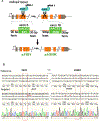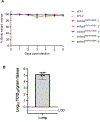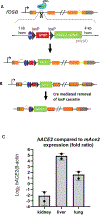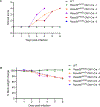Generation of a humanized mAce2 and a conditional hACE2 mouse models permissive to SARS-COV-2 infection
- PMID: 38488938
- PMCID: PMC11955088
- DOI: 10.1007/s00335-024-10033-8
Generation of a humanized mAce2 and a conditional hACE2 mouse models permissive to SARS-COV-2 infection
Abstract
The Severe Acute Respiratory Syndrome Coronavirus-2 (SARS-CoV-2) remains a public health concern and a subject of active research effort. Development of pre-clinical animal models is critical to study viral-host interaction, tissue tropism, disease mechanisms, therapeutic approaches, and long-term sequelae of infection. Here, we report two mouse models for studying SARS-CoV-2: A knock-in mAce2F83Y,H353K mouse that expresses a mouse-human hybrid form of the angiotensin-converting enzyme 2 (ACE2) receptor under the endogenous mouse Ace2 promoter, and a Rosa26 conditional knock-in mouse carrying the human ACE2 allele (Rosa26hACE2). Although the mAce2F83Y,H353K mice were susceptible to intranasal inoculation with SARS-CoV-2, they did not show gross phenotypic abnormalities. Next, we generated a Rosa26hACE2;CMV-Cre mouse line that ubiquitously expresses the human ACE2 receptor. By day 3 post infection with SARS-CoV-2, Rosa26hACE2;CMV-Cre mice showed significant weight loss, a variable degree of alveolar wall thickening and reduced survival rates. Viral load measurements confirmed inoculation in lung and brain tissues of infected Rosa26hACE2;CMV-Cre mice. The phenotypic spectrum displayed by our different mouse models translates to the broad range of clinical symptoms seen in the human patients and can serve as a resource for the community to model and explore both treatment strategies and long-term consequences of SARS-CoV-2 infection.
© 2024. The Author(s), under exclusive licence to Springer Science+Business Media, LLC, part of Springer Nature.
Conflict of interest statement
Figures







References
-
- Al-Aly Z, Xie Y, Bowe B (2021) High-dimensional characterization of post-acute sequelae of COVID-19. Nature 594, 259–264 - PubMed
-
- Bao L, Deng W, Huang B, Gao H, Liu J, Ren L, Wei Q, Yu P, Xu Y, Qi F, Qu Y, Li F, Lv Q, Wang W, Xue J, Gong S, Liu M, Wang G, Wang S, Song Z, Zhao L, Liu P, Zhao L, Ye F, Wang H, Zhou W, Zhu N, Zhen W, Yu H, Zhang X, Guo L, Chen L, Wang C, Wang Y, Wang X, Xiao Y, Sun Q, Liu H, Zhu F, Ma C, Yan L, Yang M, Han J, Xu W, Tan W, Peng X, Jin Q, Wu G, Qin C (2020) The pathogenicity of SARS-CoV-2 in hACE2 transgenic mice. Nature 583, 830–833 - PubMed
MeSH terms
Substances
Grants and funding
LinkOut - more resources
Full Text Sources
Medical
Molecular Biology Databases
Research Materials
Miscellaneous

